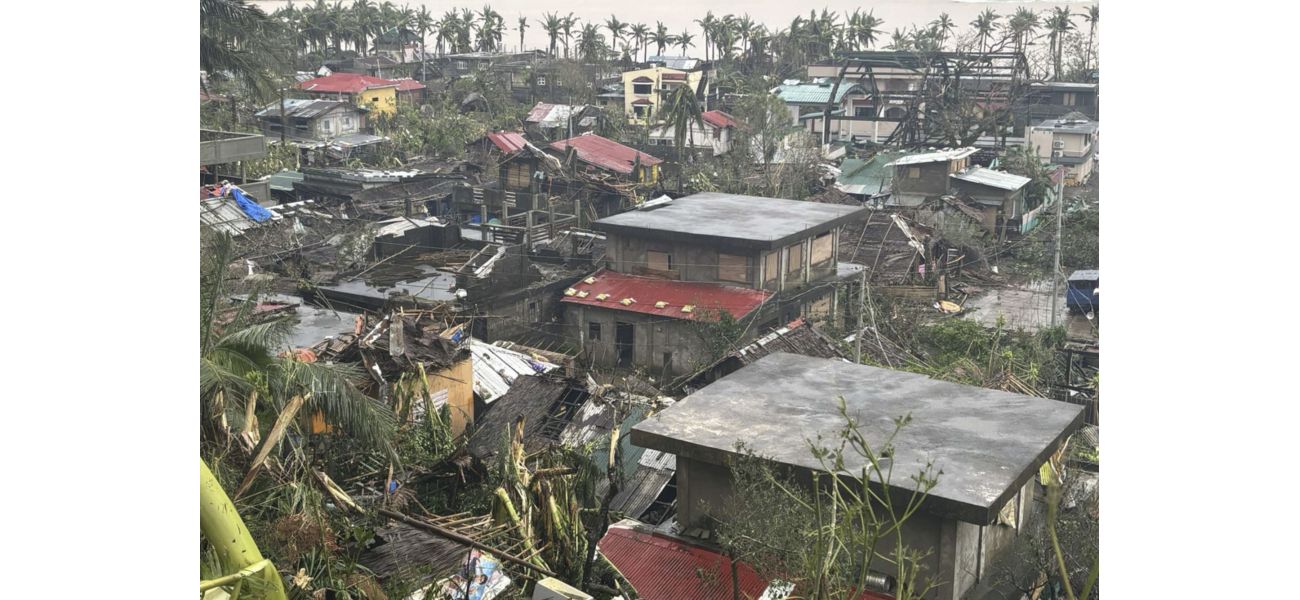400,000 people displaced as Philippines hit by powerful typhoon
Roberto Monterola, a disaster-mitigation officer, described the strong winds and high tidal surges reaching 7 meters in Catanduanes, creating a scary scene.
November 17th 2024.

On Sunday, Typhoon Man-yi made its way through the northern Philippines, causing widespread destruction and forcing many to flee to safety. This was the sixth major storm to hit the country in less than a month, leaving behind a trail of devastation and chaos.
The typhoon first made landfall on Saturday night in the eastern province of Catanduanes, with winds reaching up to 195 kilometers per hour and gusts of up to 240 kph. The country's weather agency issued a warning of a "potentially catastrophic and life-threatening situation" for provinces in its path.
As the typhoon continued to move northwestward on Sunday, the most populous region of the archipelago, northern Luzon, braced for impact. Although the capital region of metropolitan Manila was expected to be spared from a direct hit, it was still placed under storm alerts, along with other outlying regions, and warned of dangerous coastal storm surges.
According to Roberto Monterola, a disaster-mitigation officer in Catanduanes, there were no immediate reports of casualties from the typhoon. However, the strong winds and towering tidal surges caused extensive damage to houses and left the entire province without power. The disaster-response teams were also assessing the extent of damage caused by previous storms.
Monterola described the scene as "eerie" with the howling winds and tidal surges reaching over 7 meters near the seaside houses. He also mentioned that the villagers were still recovering from the previous storm and were once again faced with devastation from Typhoon Man-yi.
The island province of Catanduanes, home to 80,000 people, saw nearly half of its population seeking shelter in evacuation centers. The officials were so concerned about the safety of the villagers that they threatened to arrest those who did not follow orders to evacuate.
In total, almost 400,000 people sought refuge in emergency shelters, including churches and a shopping mall, due to Man-yi and two previous storms that hit the northern Philippines. The back-to-back storms and typhoons have left over 160 people dead, affected 9 million individuals, and caused extensive damage to homes, infrastructure, and farmlands.
In an emergency meeting held as Typhoon Man-yi approached, President Ferdinand Marcos Jr. urged his Cabinet and provincial officials to prepare for the "worst-case scenario." As a result, at least 26 domestic airports and two international airports were temporarily shut, and inter-island ferry and cargo services were suspended, leaving thousands of passengers stranded.
The United States, Manila's treaty ally, along with other neighboring countries, provided aid to the government's overwhelmed disaster-response agencies. Last month, the first major storm, Trami, caused widespread devastation and claimed many lives after dumping one to two months' worth of rain in just 24 hours.
The Philippines, a country that is battered by about 20 typhoons and storms each year, is also prone to earthquakes and has numerous active volcanoes. This makes it one of the world's most disaster-prone nations, and the recent back-to-back storms have once again highlighted the need for preparedness and aid from the international community.
The typhoon first made landfall on Saturday night in the eastern province of Catanduanes, with winds reaching up to 195 kilometers per hour and gusts of up to 240 kph. The country's weather agency issued a warning of a "potentially catastrophic and life-threatening situation" for provinces in its path.
As the typhoon continued to move northwestward on Sunday, the most populous region of the archipelago, northern Luzon, braced for impact. Although the capital region of metropolitan Manila was expected to be spared from a direct hit, it was still placed under storm alerts, along with other outlying regions, and warned of dangerous coastal storm surges.
According to Roberto Monterola, a disaster-mitigation officer in Catanduanes, there were no immediate reports of casualties from the typhoon. However, the strong winds and towering tidal surges caused extensive damage to houses and left the entire province without power. The disaster-response teams were also assessing the extent of damage caused by previous storms.
Monterola described the scene as "eerie" with the howling winds and tidal surges reaching over 7 meters near the seaside houses. He also mentioned that the villagers were still recovering from the previous storm and were once again faced with devastation from Typhoon Man-yi.
The island province of Catanduanes, home to 80,000 people, saw nearly half of its population seeking shelter in evacuation centers. The officials were so concerned about the safety of the villagers that they threatened to arrest those who did not follow orders to evacuate.
In total, almost 400,000 people sought refuge in emergency shelters, including churches and a shopping mall, due to Man-yi and two previous storms that hit the northern Philippines. The back-to-back storms and typhoons have left over 160 people dead, affected 9 million individuals, and caused extensive damage to homes, infrastructure, and farmlands.
In an emergency meeting held as Typhoon Man-yi approached, President Ferdinand Marcos Jr. urged his Cabinet and provincial officials to prepare for the "worst-case scenario." As a result, at least 26 domestic airports and two international airports were temporarily shut, and inter-island ferry and cargo services were suspended, leaving thousands of passengers stranded.
The United States, Manila's treaty ally, along with other neighboring countries, provided aid to the government's overwhelmed disaster-response agencies. Last month, the first major storm, Trami, caused widespread devastation and claimed many lives after dumping one to two months' worth of rain in just 24 hours.
The Philippines, a country that is battered by about 20 typhoons and storms each year, is also prone to earthquakes and has numerous active volcanoes. This makes it one of the world's most disaster-prone nations, and the recent back-to-back storms have once again highlighted the need for preparedness and aid from the international community.
[This article has been trending online recently and has been generated with AI. Your feed is customized.]
[Generative AI is experimental.]
0
0
Submit Comment





